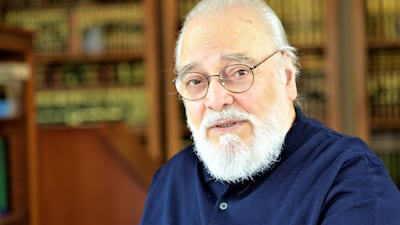Ali Omar Ermes, a renowned artist who worked in contemporary calligraphy, has died.
Ermes was born in the Libyan capital of Tripoli in 1945 and studied at the University of Plymouth in the UK. He earned a master's degree at what became Central Saint Martins, in London, where he lived from 1981 onwards.
He successfully straddled the spheres of calligraphy and western art. His artworks are collected by major art institutions such as the British Museum in London, the Ashmolean Museum in Oxford, the Barjeel Art Foundation in Sharjah, and the Smithsonian Institution in Washington, DC.
Sultan Al Qassemi shared a picture of himself with Ali Omar Ermes, left:
The work was painterly, often isolating a single letter and allowing to allude to a well-known poem or Islamic principle, rather than perfectly transcribing a painting or saying. The Seventh Ode (1993), for example, relates to the Al Muallaqat As Sabaa, a collection of seven pre-Islamic Arabic poems.
Some of these were embroidered on gold cloth and hung over the Kaaba – a history the work alludes to in its gold colouring. The kinetic, painted background suggests the variations of cloth while the written lines of the poem surround the central word of the painting.
He also addressed topics such as the environmental crisis, man’s abuse of nature, and historical events in Arab and Libyan history, such as the Libyan resistance movements of the 1920s and 1930s.

While his subject matter was rooted in his Islamic identity, the thick lines of the letters allowed them to function as canvases in themselves, often incorporating abstract compositions within their very bounds.
Ermes deliberately explored the ability of his artwork to function both within the realm of Islamic calligraphy and secular painting, and in his media appearances and given papers sought to bridge the two cultures of Libyan and British that he lived between.
He was also a great intellect, and frequently published papers on Islamic heritage, faith and Arab identity. These contributions, often to events organised by universities, took stock of western Islamophobia and lack of familiarity with Arab art forms such as calligraphy – which he sought to support.
From the 1970s, he worked to help the infrastructure around Arab art abroad, assisting the World of Islam Festival in London in 1976 and later chairing the Muslim Cultural Heritage Centre in the city.


